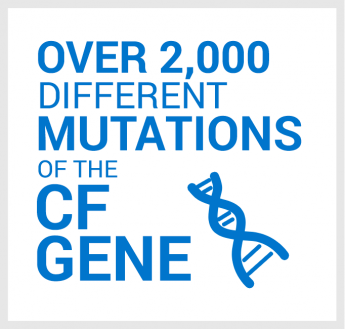NEW SURVIVAL MILESTONE FOR CYSTIC FIBROSIS IS CAUSE FOR CELEBRATION BUT NOT INACTION
TORONTO (February 27, 2024) – New data released today by Cystic Fibrosis Canada show that life-changing treatments are increasingly reaching the 4,445 Canadians with cystic fibrosis (CF) and that Canadians born with CF today will live longer than those who came before them. But there’s another, less-rosy side to the story: more than half of Canadians who died of CF in 2022 didn’t reach their 40th birthday. Many are still very ill and one in seven living with the disease today is ineligible for the treatments making such a positive difference for others with CF.
The information in the Canadian Cystic Fibrosis Registry 2022 Annual Data Report published by Cystic Fibrosis Canada tells a story of continued progress in cystic fibrosis compared to data from previous years:
- For the first time, the estimated median age of survival has reached the milestone of 60 years of age. In other words, half of babies born with CF today are expected to live beyond their 60th birthday, compared to their 52nd birthday as reported in the 2017 edition of the report and 37th birthday in 2002.
- The number of Canadians with CF who are taking CFTR modulator therapies (drugs that help certain mutant CF proteins function better) has increased by 70% (approximately 2,500 people in 2022 compared to approximately 1,500 in 2021). For many people living with CF, CFTR modulator therapies offer a significant advantage in managing their disease. CF Canada worked diligently with community advocates to ensure the drug Trikafta is a treatment option that is covered by public and private drug plans. There is still work to be done to increase access and have it funded for everyone who can benefit.
“Steady growth in the median age of survival is an indicator of the advancements in CF care, our investments in research, new treatments and the efforts that patients put into maintaining their health,” said Dr. Paul Eckford, Chief Scientific Officer, Cystic Fibrosis Canada. “Yet while the data are pointing in the right direction, cystic fibrosis is still a fatal disease, people still have a high treatment burden and there is much work to be done.”
The report highlights the continued challenges of living with CF from a healthcare and quality of life perspective, including those who are unable to benefit from recent life-changing treatments:
- In contrast to the survival milestone, the 40 Canadians who died of CF in 2022 had a median age of 38.
- Canadians with CF collectively had 17,000 clinic visits, spent 10,000 days in hospital, and spent nearly 6,000 days on intravenous antibiotics in 2022 alone. While these numbers represent decreases over previous years, they indicate a disease with a significant toll on daily life as well as Canada’s healthcare system.
- One in five Canadian adults with CF has depression or anxiety recorded as a complication in the CF Registry, reflecting international work showing elevated rates of these mental health conditions in the CF community.
“As we face a new day in CF with a new treatment that can make a difference for some people, there is a significant population – one in every seven people with CF – whose genetic mutations mean they cannot access these treatments, and more whose CF has progressed past the point of full benefit. These people cannot be left behind,” said Kelly Grover, President and CEO, Cystic Fibrosis Canada. “In addition, progress in CF has surfaced new questions that require exploration: what are the needs of a population that is living longer than ever before with CF? What does aging with CF look like? We also don’t know the long-term impact of Trikafta and how well it will continue to work. The progress we’ve already made motivates us to continue working hard to find the answers to these questions and ensure all Canadians affected by CF can benefit today and in the future.”
For Canadians like Vicky Maldonado, the data report provides a hopeful outlook for future generations of families affected by CF. But it does little to change the reality for her six-year-old son, Sebastian. Because of the very rare genetic mutations causing Sebastian’s CF and in spite of the family’s advocacy efforts, he is ineligible for the new therapies that are helping so many others with the disease. For now, Sebastian spends three hours a day doing treatments; more if he has an infection, which can also require hospitalization.
“This disease is still a ticking clock for us and others,” says Vicky. “Without Trikafta or other options, Sebastian faces continued CF dysfunction and inevitable lung failure. All we want is for him to have a full, long adventurous life that he deserves,
The Canadian Cystic Fibrosis Registry Annual Data Report has long provided valuable real-world information that quantifies what it is to live with CF at a population level. It includes demographic information like the age and location of Canada’s CF population and its composition by genetic mutation; insights into the lung function, body mass index, and respiratory health of Canadians living with CF as well as their use of therapies; number of interactions with the health care system; rate of complications such as diabetes, mental health concerns; and survival data.
Access the Canadian Cystic Fibrosis Registry Annual Data Report on our website.
About Cystic Fibrosis
Cystic fibrosis is the most common fatal genetic disease affecting Canadian children and young adults. There is no cure. Of the Canadians with cystic fibrosis who died in the past five years, half were under the age of 38. Cystic fibrosis is a progressive, degenerative multi-system disease that affects mainly the lungs and digestive system. In the lungs, where the effects are most devastating, a build-up of thick mucus causes severe respiratory problems. Mucus and protein also build up in the digestive tract, making it difficult to digest and absorb nutrients from food. In addition to the physical effects of the disease, mental health concerns are emerging; anxiety and depression are common among this population. Double lung transplants are the final option for patients with end-stage disease; most fatalities of people with cystic fibrosis are due to lung disease.
About Cystic Fibrosis Canada
Cystic Fibrosis Canada has dramatically changed the cystic fibrosis story, advancing research and care that has more than doubled life expectancy. Since being founded by parents in 1960, Cystic Fibrosis Canada has grown into a leading organization with a central role engaging people living with cystic fibrosis, parents and caregivers, volunteers, researchers and healthcare professionals, government and donors, all working together to change lives through treatments, research, information, support and connection. Cystic Fibrosis Canada has launched a clinical trials network and today 100 per cent of our population can be referred to a trial—bringing new and improved treatments to our community. Cystic Fibrosis Canada has also set the standard for advocacy work, driving changes to the healthcare system to enable approval and funding for the life-changing medicine, Trikafta, at record speed. Because of this work, children born with the disease today will have a much different, more positive path than even a decade ago. While we celebrate that progress and are proud of the treatment options Cystic Fibrosis Canada helped bring to this country, we still have much work to do. Trikafta is not a cure. People are still very sick from this disease and far too many are dying far too young. We applaud?this life-changing treatment, yet it means very little if not everyone can benefit from it. And for those who may never benefit from it, we need new solutions.? We still have much work to do to ensure healthy, full lives for everyone.
---
For more information, please contact:
Chloe Hall
chall@cysticfibrosis.ca




